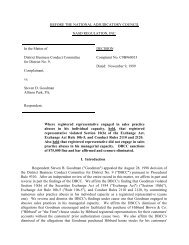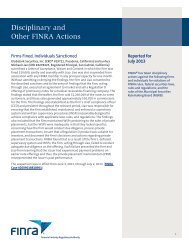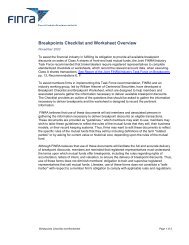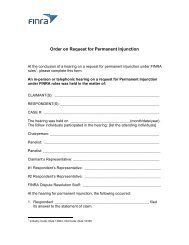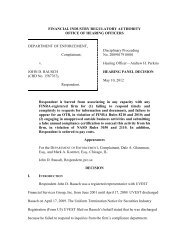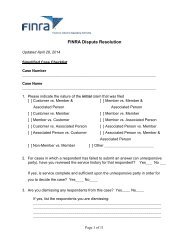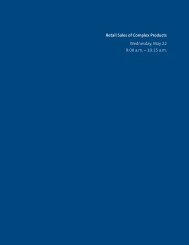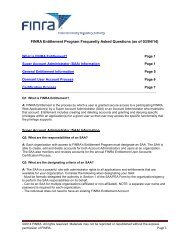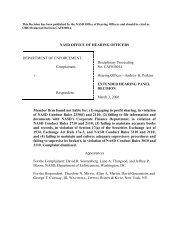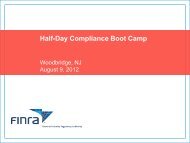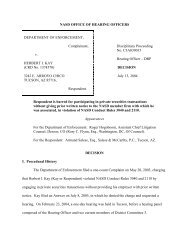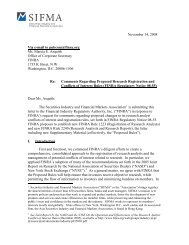NASD REGULATION, INC - finra
NASD REGULATION, INC - finra
NASD REGULATION, INC - finra
You also want an ePaper? Increase the reach of your titles
YUMPU automatically turns print PDFs into web optimized ePapers that Google loves.
DEPARTMENT OF ENFORCEMENT,<br />
v.<br />
DANIEL ERIC KELSEY<br />
(CRD #3031423)<br />
2128 Monroe<br />
Grand Rapids, MI 49505,<br />
<strong>NASD</strong> OFFICE OF HEARING OFFICERS<br />
Complainant,<br />
Respondent.<br />
Disciplinary Proceeding<br />
No. C8A020088<br />
Hearing Panel Decision<br />
Hearing Officer— SW<br />
Dated: June 29, 2004<br />
For violating <strong>NASD</strong> Conduct Rule 2110 by negligently making<br />
misleading misrepresentations to four customers, Respondent was<br />
suspended for 60 days from associating with any member firm in any<br />
capacity and ordered to re-qualify as an investment company variable<br />
contracts products representative within 60 days of the termination of<br />
his suspension.<br />
In addition, Respondent was fined $7,000, $2,500, and $5,000 for<br />
violating <strong>NASD</strong> Conduct Rule 2110 and IM-1000-1 by (i) failing to<br />
timely update his 1998 Form U-4, (ii) filing an inaccurate 1998 Form<br />
U-4, and (iii) failing to disclose his entire ten-year employment history<br />
on his 1998 and 2000 Form U-4s.<br />
The Hearing Panel found that Respondent’s failure to disclose his<br />
entire ten-year employment history on his 2000 Form U-4 was willful<br />
within the meaning of Section 15(b)(4)(A) of the Securities Exchange<br />
Act of 1934.<br />
Appearances<br />
Kevin G. Kulling, Esq., Regional Attorney, and Richard S. Schultz, Esq.,<br />
Regional Counsel, Chicago, Illinois, for the Department of Enforcement.<br />
Frederick K. Hoops, Esq., and Anthony R. Paesano, Esq., Detroit, Michigan, for<br />
Respondent Daniel Eric Kelsey.<br />
DECISION
I. Introduction<br />
The Department of Enforcement (“Enforcement”) filed an eight-count Complaint<br />
against Daniel Eric Kelsey (“Respondent”). Counts one, two, three, and four of the<br />
Complaint allege that Respondent violated Section 10(b) of the Securities Exchange Act<br />
of 1934 (“Exchange Act”), SEC Rule 10b-5 thereunder, and <strong>NASD</strong> Conduct Rules 2120<br />
and 2110, by making fraudulent misrepresentations or omissions to four customers to<br />
induce their purchase of variable universal life insurance policies. Count five of the<br />
Complaint alleges, in the alternative, that if the above conduct was not fraudulent, it<br />
violated <strong>NASD</strong> Conduct Rule 2110.<br />
Counts six, seven, and eight of the Complaint allege that Respondent violated<br />
<strong>NASD</strong> Conduct Rule 2110 and IM-1000-1 by: (i) failing to timely update his 1998 Form<br />
U-4; (ii) filing an inaccurate 1998 Form U-4; and (iii) failing to disclose his entire ten-<br />
year employment history on his 1998 and 2000 Form U-4s. The Complaint alleges that<br />
each of the Form U-4 violations was willful.<br />
Respondent filed an Answer to the Complaint and requested a hearing.<br />
Respondent denied the allegations of counts one through five of the Complaint.<br />
Respondent admitted the allegations of counts six through eight of the Complaint.<br />
However, Respondent argued that the errors on the Form U-4s were not material, and<br />
were not intentional, but rather were the result of his inexperience. Accordingly,<br />
Respondent argued that the errors were not willful. A hearing on the charges was held<br />
2
efore a Hearing Panel composed of an <strong>NASD</strong> Hearing Officer and two members of the<br />
District 8 Committee. 1<br />
A. Respondent<br />
II. Discussion<br />
Respondent first became registered with <strong>NASD</strong> as an investment company and<br />
variable contracts products representative through Hornor, Townsend & Kent, Inc.<br />
(“HTK”) on May 14, 1998. (CX-1, pp. 3-4). Respondent remained registered with HTK<br />
until November 2, 2000. (Id.). While registered with HTK, Respondent worked out of<br />
the local office of Riverfront Financial Group (“Riverfront Financial”), a general<br />
insurance agency for Penn Mutual Life Insurance Company (“Penn Mutual”). 2 (Tr. p.<br />
301). On October 18, 2000, Penn Mutual dismissed Respondent for providing false<br />
information on his 1998 Form U-4. (CX-19; Tr. p. 462).<br />
Since December 4, 2000, Respondent has been registered with <strong>NASD</strong> as an<br />
investment company and variable contracts products representative through MML<br />
Investors Services, Inc. (“MML”). 3 (CX-1, p. 3).<br />
B. Respondent Made Misrepresentations to his Customers<br />
Counts one, two, three, four, and five of the Complaint allege that Respondent<br />
made misrepresentations or omissions to four customers to induce their purchase of<br />
1 References to the testimony set forth in the transcripts of the Hearing will be designated as “Tr. p.” with<br />
the appropriate page number. References to the exhibits provided by Enforcement will be designated as<br />
“CX-”; references to the exhibits provided by Respondent will be designated as “RX-”.<br />
2 HTK is wholly owned subsidiary of Penn Mutual. (RX-24, p. 32).<br />
3 Since Respondent was registered when the Complaint was filed, <strong>NASD</strong> has jurisdiction over this<br />
proceeding.<br />
3
variable universal life insurance (“VUL”) policies issued by Penn Mutual. 4 The<br />
allegations of misleading statements may be divided into two types:<br />
(i) misrepresentations regarding Respondent’s personal history; and<br />
(ii) misrepresentations concerning the VUL policies.<br />
1. Misrepresentations Regarding Respondent’s Personal History<br />
In the late summer or fall of 1999, Respondent met Mr. BG, who was president of<br />
both Professional Benefit Services (“PBS”) and its affiliate Professional Benefit<br />
Retirement Services (“PBRS”), and Ms. CS, who was vice president in charge of<br />
marketing for PBRS. 5<br />
Mr. BG and Ms. CS contacted Respondent as someone with expertise in<br />
retirement planning because they needed advice regarding the development of an<br />
investment product described as a variable employment medical account (“VEMA”). 6<br />
(Tr. pp. 61-62, 136, 197).<br />
Mr. BG and Ms. CS stated that, in connection with their meeting with Respondent<br />
in 1999, Respondent provided them with certain information about his personal<br />
background, i.e., that: (i) he had attended Michigan State University (“Michigan State”);<br />
(ii) he was in his second or third year of law school; (iii) he had his Series 7 license; and<br />
(iv) he had managed two or three brokerage funds in Chicago. (Tr. pp. 63, 136-139, 157).<br />
Mr. BG and Ms. CS subsequently produced a marketing brochure for the VEMA product<br />
4 VUL polices are sold by registered representatives of HTK who are also appointed and licensed as<br />
insurance agents. (RX-24, p. 32).<br />
5 PBS is a third party administrator of self-funded insurance benefits claims for active employees. (Tr. p.<br />
54). PBRS was a spin off of PBS and provided insurance administrative services for retirees. (Tr. p. 52).<br />
6 The VEMA product was designed to provide a method for active employees to pre-fund retiree medical<br />
expenses and thereby permit corporations to control their FASB 106 liabilities. (Tr. pp. 136, 494-495).<br />
The Hearing Panel finds it unlikely that Respondent, who had been in the insurance field for less than one<br />
year, would have had a general reputation as an expert in retirement planning.<br />
4
that included the representation that Respondent had managed money for three brokerage<br />
firms in Chicago. (Tr. p. 412).<br />
Respondent had attended Ferris State University, not Michigan State; he was not<br />
attending and had never attended law school; he did not have a Series 7 license; and he<br />
had never managed a brokerage firm. (Tr. pp. 657, 664).<br />
Based on: (i) the demeanor of Mr. BG and Ms. CS; (ii) the admissions by<br />
Respondent that he had spoken to Mr. BG about attending Michigan State and taking the<br />
law school admissions test (“LSAT”); and (iii) the production of the marketing brochure,<br />
which included the misrepresentation that Respondent had managed brokerage firms, the<br />
Hearing Panel finds that there is a preponderance of credible evidence that Respondent<br />
misled Mr. BG and Mrs. CS about his personal history. 7<br />
2. Misrepresentations Regarding VUL Policies<br />
After working together for several months on the VEMA product, Respondent<br />
solicited Mr. BG and Ms. CS to purchase Penn Mutual VUL policies. (Tr. pp. 201-202).<br />
Respondent also made VUL presentations to Ms. CW, vice president of marketing of<br />
PBS, and to Ms. CE, the director of operations of PBS, who also managed human<br />
resources and benefits. (Tr. pp. 27, 105). Respondent spoke to Mr. BG, Ms. CS, and Ms.<br />
CE as a group about the concept of variable life insurance, but he also made individual<br />
presentations to each customer. 8 (Tr. p. 505).<br />
7 Respondent does not dispute that he told Mr. BG that he had attended Michigan State. (Tr. pp. 563-564).<br />
Respondent denied that he told Mr. BG and Ms. CS that: (i) he had managed brokerage funds in Chicago;<br />
(ii) he had a Series 7 license; and (iii) he was attending law school, but he admitted he might have told Mr.<br />
BG that he had taken the LSAT and that he intended to go to law school. (Tr. p. 664).<br />
8 Ms. CW was not at the group presentation because she was traveling. (Tr. pp. 28-29).<br />
5
a. The VUL Policies<br />
The Penn Mutual VUL policy, in addition to a death benefit, contains an<br />
investment element, which fluctuates based on the performance of investment portfolios<br />
maintained by the insurance company in a segregated or separate account. 9 The VUL<br />
policy is a flexible premium product; the customer has a certain amount of discretion in<br />
selecting what premiums to pay, generally in amounts ranging from the “no-lapse”<br />
premium up to the “guideline” premium. (Tr. pp. 240-241).<br />
The guideline premium for the VUL policy is the maximum premium that can be<br />
made without the policy being classified as something other than a life insurance product.<br />
(Tr. p. 241). The no-lapse premium is the minimum premium payment necessary to<br />
guarantee the existence of the policy for the first three years. 10 (Tr. pp. 241-242). The<br />
premium specified by the customer to be paid is known as the planned premium. If a<br />
customer chose to pay his premiums on a monthly basis, the customer was required to<br />
pay via “Penn Check,” which involved an automatic debit of the monthly planned<br />
premium from the customer’s bank account. (Tr. 246).<br />
The prospectus for the VUL policy states that the amount of the required initial<br />
premium payment depends on a number of factors, such as age, sex, rate classification,<br />
the amount of insurance specified in the application, and any supplemental benefits. (RX-<br />
24, p. 5). The insured may make additional premium payments in any amount at any<br />
time but a premium payment must be at least $25. (Id.). The insured, however, must pay<br />
9 The separate account is distinct from the insurance company’s general account that comprises the assets<br />
of the insurance company that issues the policy. (<strong>NASD</strong> Notice to Members 00-44 (July 2000)).<br />
10 There is also the “target” premium, which is most analogous to a whole life premium for an equivalent<br />
amount of traditional life insurance and is an amount greater than the no-lapse premium. (Tr. pp. 241-242).<br />
Penn Mutual paid commissions on the VUL policies based in part on the relationship between the<br />
premiums paid by the customer and the target premium of the policy. (Tr. p. 351).<br />
6
enough premiums to maintain a net cash surrender value for the policy sufficient to pay<br />
policy charges. 11 (RX-24, p. 5; Tr. pp. 243-244).<br />
b. Customer BG<br />
Count one of the Complaint alleges that Respondent committed fraud, in violation<br />
of Section 10(b) of the Exchange Act, SEC Rule 10b-5 thereunder, and <strong>NASD</strong> Conduct<br />
Rules 2120 and 2110, by making misrepresentations to Mr. BG to induce him to purchase<br />
a VUL policy. Mr. BG testified that based upon Respondent’s representation that his<br />
initial premium would be $4,000, and that the subsequent monthly premium would be<br />
$1,500 to $2,000 per month, he purchased a $2,000,000 VUL policy from Penn Mutual.<br />
(Tr. p. 147).<br />
Respondent confirmed that he told Mr. BG that Penn Mutual would accept a<br />
$1,500 to $2,000 monthly premium. (Tr. p. 595). Mr. BG’s VUL policy, as issued, had a<br />
monthly planned premium of $4,000. (RX-14, p. 3).<br />
c. Customer CS<br />
Count two of the Complaint alleges that Respondent committed fraud by making<br />
misrepresentations to Ms. CS about her ability to contribute to, and withdraw funds from,<br />
the policy in order to induce her to purchase a VUL policy. Ms. CS testified that she<br />
purchased a $200,000 VUL policy from Penn Mutual based upon Respondent’s<br />
representation that she could contribute or withdraw any amount of money from the<br />
policy at any time, without penalty. (Tr. p. 67).<br />
11 The Penn Mutual illustration provided to customers when soliciting the purchase of an insurance policy<br />
stated, “During the first 3 policy years if the sum of all premiums paid on this policy, reduced by any<br />
partial surrenders, policy loans and unpaid interest, is greater than the no-lapse premium multiplied by the<br />
number of months the policy has been in force, the policy is guaranteed not to lapse even if the net cash<br />
surrender value is zero or less.” (RX-7, p. 13). “If less than the no-lapse premium is paid during the first 3<br />
policy years, the policy will not necessarily lapse provided the net cash surrender value is greater than<br />
zero.” (Id.).<br />
7
Respondent confirmed that he advised Ms. CS that she was not limited in the<br />
amount that she could contribute to the policy. The policy as issued provided that<br />
surrender charges apply to policy surrenders for the first 11 years from issue. (RX-9, p.<br />
3). With respect to deposits into a policy, Penn Mutual’s illustration provided that any<br />
deposits to the policy would be monitored for compliance with the Guideline Premium-<br />
Cash Value Corridor test, and the effect of such test could be to limit the premiums that<br />
could be paid into the policy and/or increase the amount of the death benefit. (Id.).<br />
d. Customer CE<br />
Count three of the Complaint alleges that Respondent committed fraud by making<br />
misrepresentations to Ms. CE regarding the amount of her monthly premium. Ms. CE<br />
testified that she purchased a $200,000 policy based on Respondent’s representation that<br />
the initial premium would be approximately $259 and that the subsequent planned<br />
premiums would be $130 per month. (Tr. pp. 110, 113).<br />
Respondent confirmed that he told Ms. CE that $130 would keep her policy in<br />
force, depending on the market. (Tr. pp. 598-599). Ms. CE’s VUL policy, as issued, set<br />
forth a monthly planned premium of $259.50. (RX-16, p. 2).<br />
e. Customer CW<br />
Count four of the Complaint alleges that Respondent committed fraud by making<br />
misrepresentations to Ms. CW regarding the amount of her monthly premium. Ms. CW<br />
testified that she purchased a $1,000,000 VUL policy based on Respondent’s<br />
representations that she could deposit as much as she wanted into the policy and that the<br />
monthly premiums would be $500 per month. (Tr. p. 34).<br />
8
Respondent confirmed that he told Ms. CW the monthly premium would be about<br />
$1,000, but that $500 would be acceptable. (Tr. pp. 596, 629-630). Ms. CW’s policy, as<br />
issued, set forth a monthly planned premium of $2,000. (RX-17, p. 8).<br />
f. Customers’ Complaints<br />
In October 2000, HTK and its affiliate Penn Mutual terminated Respondent for<br />
misrepresenting on his 1998 Form U-4 that he had attended Michigan State. 12<br />
Subsequently, Jim Yost, equity coordinator at HTK, contacted Mr. BG to direct him to<br />
stop using the VEMA product brochure. (Tr. pp. 387, 418-419).<br />
At the meeting with Mr. BG, Mr. Yost agreed to answer questions that Mr. BG,<br />
Ms. CS, Ms. CW, and Ms. CE had about their VUL policies. (Tr. pp. 419-420). The<br />
customers complained that: (i) their policies listed higher monthly planned premiums<br />
than agreed, and (ii) Respondent had not gotten their planned premium deductions<br />
corrected. 13 (Tr. pp. 420-421).<br />
Mr. Yost advised each of the customers that Penn Mutual would not have<br />
authorized the VUL policies for the premiums that Respondent had quoted to them. (Tr.<br />
p. 421). In addition, Mr. Yost advised Ms. CS that there was a maximum of $40,122.00<br />
that could be deposited in her policy each year. 14 (CX-27, p. 3).<br />
Based on Mr. Yost’s representation, each of the customers wrote a complaint<br />
letter to Penn Mutual. Each of the four customers canceled their policies, and Penn<br />
12 Respondent’s registration with HTK was terminated effective November 2, 2000. (CX-1, p. 4).<br />
13 Mr. BG’s VUL policy, as issued, set forth a monthly planned premium of $4,000. (RX-14, p. 3). Ms.<br />
CE’s VUL policy, as issued, set forth a monthly planned premium of $259.50. (RX-16, p. 2). Ms. CW’s<br />
VUL policy, as issued, set forth a monthly planned premium of $2,000. (RX-17, p. 8).<br />
14 Ms. CS testified that she told Respondent that she intended to deposit between $50,000 to $100,000 into<br />
her policy. (Tr. p. 42).<br />
9
Mutual returned to the customers all of their insurance premiums in December 2000. 15<br />
(CX-5 at 18; CX-6 at 12; CX-7 at 14; CX-8 at 14).<br />
g. Respondent’s Representations Regarding Planned Premiums and<br />
Ability to Deposit or Withdraw Funds were Misrepresentations<br />
There is practically no dispute regarding the representations made by Respondent<br />
concerning the cost of the VUL policies or the customers’ ability to deposit or withdraw<br />
funds from the policies. Respondent advised Mr. BG that he could initiate his policy for<br />
$4,000 and that a monthly planned premium of $2,000 was possible. Respondent advised<br />
Ms. CE that she could initiate her policy for $259.00 and that a monthly planned<br />
premium of $130 would be possible. Respondent advised Ms. CW that she could initiate<br />
her policy for $2,000 and pay a monthly premium of $1,000. Although Respondent did<br />
not advise Ms. CS of a specific planned premium, he did advise Ms. CS that she could<br />
deposit or withdraw funds from her account without penalty.<br />
Based on the testimony of the customers, the Hearing Panel finds that the<br />
customers viewed the quoted premiums as a minimum fixed amount, which they had the<br />
option to modify to invest more funds, but which would be sufficient in all circumstances<br />
to keep the policies from lapsing. Ms. CS believed that she could deposit or withdraw<br />
funds from her account without penalty and without conditions. This was not true.<br />
Mr. Yost stated, which statement the Hearing Panel finds to be credible, that Penn<br />
Mutual would not have issued policies at the premiums quoted by Respondent because of<br />
the probability that the policies would lapse. 16 (Tr. p. 421). Pursuant to the VUL<br />
prospectus, in order to avoid monetary penalties on withdrawing or depositing funds into<br />
15 Penn Mutual reimbursed the following amounts: $10,000 to Mr. BG; $778.50 to Ms. CE; $5,000 to Ms.<br />
CW; and $411.17 to Ms. CS. (CX-5 at 18; CX-6 at 12; CX-7 at 14; CX-8 at 14).<br />
10
the policies, the customer must structure the withdrawal or deposit to meet a number of<br />
conditions.<br />
Accordingly, the Hearing Panel finds that Respondent’s representations regarding<br />
the planned premiums were misleading because he failed to disclose that, unless the<br />
investment portfolios underlying the VUL policies performed well, the customers would<br />
have to increase the planned premiums to avoid having their policies lapse. The Hearing<br />
Panel also finds that Respondent’s representations that funds could be withdrawn or<br />
deposited without penalty was misleading because he did not fully discuss the<br />
requirements that the customer would have to be meet in order to avoid paying penalties.<br />
3. Fraud Not Proven<br />
In order to establish a violation of the fraud provisions of Section 10(b) of the<br />
Exchange Act, SEC Rule 10b-5 thereunder, and <strong>NASD</strong> Conduct Rule 2120, 17<br />
Enforcement must prove by a preponderance of the evidence that: (1) Respondent made<br />
misrepresentations and/or omissions; (2) the misrepresentations and/or omissions were<br />
material; (3) the misrepresentations and/or omissions were made with scienter; 18 and (4)<br />
16 Respondent Yost testified that the customers could not have obtained the amount of insurance that they<br />
had requested for the premiums that they said they were supposed to pay. (Tr. p. 421).<br />
17 Section 10(b) of the Exchange Act makes it unlawful “to use or employ, in connection with the purchase<br />
or sale of any security . . . any manipulative or deceptive device or contrivance in contravention” of the<br />
SEC rules and regulations. SEC Rule 10b-5 provides in part that “[i]t shall be unlawful for any person,<br />
directly or indirectly, . . . (b) to make any untrue statement of a material fact or to omit to state a material<br />
fact necessary in order to make the statements made, in light of the circumstances under which they were<br />
made, not misleading.” Conduct Rule 2120, <strong>NASD</strong>’s anti-fraud rule, provides that no member shall effect<br />
any transaction in, or induce the purchase or sale of any security, by means of any manipulative, deceptive,<br />
or fraudulent device. See Prime Investors, Inc., Exchange Act Release No. 38487, 1997 SEC LEXIS 761,<br />
at *24 (Apr. 8, 1997) (making material misstatements of fact in connection with a sale of a security is a<br />
violation of <strong>NASD</strong> Conduct Rule 2120).<br />
18 Scienter requires proof that a respondent intended to deceive, manipulate, or defraud or that he acted<br />
with recklessness. See Aaron v. SEC, 446 U.S. 680, 686-87, n. 5 (1980); Ernst v. Hochfelder, 425 U.S.<br />
185, 193 (1976).<br />
11
the misrepresentations and/or omissions were made in connection with the purchase or<br />
sale of securities. 19<br />
a. Personal History Misrepresentations: Not in Connection with<br />
Purchase or Sale of Security<br />
As discussed above, the Hearing Panel finds that Respondent made<br />
misrepresentations about his personal history, when he spoke with Mr. BG and Ms. CE at<br />
their first meeting in 1999. It is also clear that Respondent made the misrepresentations<br />
intentionally. Consequently, the Hearing Panel finds that the misrepresentations were<br />
made with scienter. However, the Hearing Panel does not find that Respondent made the<br />
misrepresentations in connection with the purchase or sale of a security.<br />
The misrepresentations regarding his personal history occurred several months<br />
before either the solicitation of sale or the actual sale of the VUL policies to Mr. BG and<br />
Ms. CS. There is no suggestion that, at the time that Respondent made the personal<br />
history misrepresentations, Mr. BG, Ms. CS, or Respondent contemplated the subsequent<br />
VUL policy transactions. (Tr. p. 165). Enforcement failed to provide credible evidence<br />
of any nexus between the misrepresentations and the subsequent sale of the insurance<br />
policies.<br />
The Hearing Panel finds that the two events were independent of each other.<br />
19 For Section 10(b) of the Exchange Act and SEC Rule 10b-5 thereunder, the transactions must also<br />
involve interstate commerce or the mails, or a national securities exchange. Respondent used a means and<br />
instrumentality of interstate commerce when he communicated with the customers via telephone. See SEC<br />
v. Hasho, 784 F. Supp. 1059, 1106 (S.D.N.Y. 1992), 1992 U.S. Dist. LEXIS 1322 at **148-149 (S.D.N.Y.<br />
Feb. 14, 1992).<br />
12
Accordingly, the Hearing Panel finds that Enforcement failed to prove that Respondent<br />
made the misrepresentations about his personal history in connection with the purchase<br />
or sale of a security.<br />
In light of the Hearing Panel’s finding that the misrepresentations were not made<br />
in connection with the sale of the VUL policies, the Hearing Panel does not find it<br />
necessary to determine whether the misrepresentations were material, i.e., that the<br />
information would have altered the “total mix” of information available to the reasonable<br />
investor in making an investment decision. 20 The Hearing Panel notes that whether an<br />
individual graduated from a particular college or has a Series 7 license may not<br />
necessarily be material to the investment decision of a reasonable investor to purchase a<br />
life insurance policy.<br />
b. VUL Misrepresentations: Scienter Not Shown<br />
As discussed above, the Hearing Panel finds that misrepresentations were made<br />
with respect to the VUL policies. The Hearing Panel also finds that the<br />
misrepresentations were material, and the misrepresentations were made in the<br />
connection with the sale of a security. 21<br />
Scienter is the only remaining requirement needed to establish fraud. As<br />
discussed above, scienter requires proof that a respondent intended to deceive,<br />
manipulate, or defraud, or that he acted with recklessness. Recklessness has been defined<br />
as highly unreasonable conduct involving not merely simple or excusable negligence, but<br />
20 The test of materiality is whether a reasonable investor would consider the information significant. See<br />
Basic Inc. v. Levinson, 485 U.S. 224, 231-32 (1988). An omitted or misstated fact is thus material if it<br />
would have been viewed by a reasonable investor as having altered the “total mix” of information<br />
available. See TSC Indus., Inc. v. Northway, Inc., 426 U.S. 438, 449 (1976).<br />
21 There is no dispute that the customers considered the cost of the VUL policies to be a significant factor<br />
when deciding whether to purchase the VUL policies.<br />
13
an extreme departure from the standards of ordinary care that presents a danger of<br />
misleading buyers or sellers, which is either known to the defendant or is so obvious that<br />
the defendant must have been aware of it. 22<br />
Enforcement argued that Respondent knew at the time that he quoted the<br />
premiums to the customers that the premiums would be insufficient to initiate and<br />
maintain the insurance policies. Enforcement noted that Penn Mutual issued the<br />
insurance policies with higher monthly planned premiums than the quoted premiums.<br />
Enforcement also argued that Respondent knew that deposits and withdrawals from the<br />
policies were subject to conditions, and accordingly, he acted with scienter.<br />
The Hearing Panel finds that Respondent’s actions demonstrate that he thought<br />
the quoted premiums were sufficient. Chris Engle, HTK’s sales manager, and Mr. Yost,<br />
equity coordinator at HTK, testified that it was standard procedure to collect an upfront<br />
amount that was equal to two-months of premiums to begin a policy. (Tr. pp. 247, 387).<br />
Respondent testified that he followed the practice of collecting two months of premiums<br />
with these customers. (Tr. p. 517).<br />
Respondent quoted Mr. BG a monthly planned premium amount of $2,000 and<br />
collected $4,000 to initiate the policy. (Id.). Respondent quoted Ms. CE a monthly<br />
planned premium of $130 and collected $259 to initiate the policy. (Tr. pp. 109-110).<br />
Respondent testified that he quoted Ms. CW a monthly planned premium of $1,000 and<br />
collected $2,000 to initiate the policy. (Tr. pp. 596-597).<br />
In response to the question why the policies as issued showed a higher monthly<br />
planned premium, Respondent testified that it was a “glitch.” (Tr. p. 632). Respondent<br />
22 Tuchman v. DSC Communications Corp., 14 F.3d 1061, 1067 (5 th Cir. 1994), 1994 U.S. App. LEXIS<br />
3326 at **14 (1994).<br />
14
testified that the $4,000 monthly premium set forth in the policy was an error and that he<br />
corrected the error, but “it was too late . . . [BG] and everyone were already filing<br />
complaints.” (Tr. pp. 516-517). The Hearing Panel notes that Penn Mutual reduced Mr.<br />
BG’s and Ms. CW’s monthly planned premiums to $2,000 and $1,000, respectively,<br />
before it repaid the customers all of their premium payments in December 2000. 23<br />
The Hearing Panel finds that Respondent quoted the premiums based on his<br />
understanding that a VUL policy provides that premiums may be changed every month<br />
and the amounts due depend in part on the investment experience of the investment<br />
portfolio chosen by the customer. 24 Respondent testified that only when the cash value<br />
of the policy gets lower than the actual cost of the insurance does Penn Mutual become<br />
concerned about the policy lapsing. 25 (Tr. p. 515).<br />
With respect to the withdrawing or depositing of funds without penalty, funds<br />
may be withdrawn if the net cash surrender value remaining in the policy exceeds $1,000,<br />
and funds may be deposited in excess of the Guideline premium if the death benefits<br />
were changed. (RX-24, pp. 15, 17). Due to the VUL’s flexibility, the determination of<br />
whether a particular policy would be a modified endowment contract and subject to<br />
penalties depended on the individual circumstances of each policy. (RX-24, p. 30).<br />
Accordingly, the Hearing Panel finds that Enforcement failed to show by a<br />
preponderance of the evidence that Respondent acted with scienter when he quoted the<br />
23 Penn Mutual reimbursed Mr. BG $10,000, i.e., two payments of $4,000, and one payment of $2,000, and<br />
reimbursed Ms. CW $5,000, i.e., two payments of $2,000, and one payment of $1,000. (CX-5, p. 2; CX-7,<br />
p. 2).<br />
24 At the time of the purchase of the VUL policies, even Mr. BG thought that the May 2000 market break<br />
was just a short-term glitch. (Tr. p. 205).<br />
25 Mr. BG’s monthly cost of insurance was $2,229.94. (RX-14, p. 3). Ms. CS’s monthly cost of insurance<br />
was $79.78. (RX-15, p. 2). Ms. CE’s monthly cost of insurance was $124.71. (RX-16, p. 2). Ms. CW’s<br />
monthly cost of insurance was $191.19. (RX-17, p. 2).<br />
15
premiums to the customers or when he disclosed that deposits or withdrawals could be<br />
made without penalty. 26<br />
c. Fraud Charges Dismissed<br />
Having found that Enforcement failed to prove that: (i) the personal history<br />
misrepresentations were made in connection with the purchase or sale of a security; and<br />
(ii) the VUL policy misrepresentations were made with scienter, the Hearing Panel<br />
dismisses the charges that Respondent’s misrepresentations violated Section 10(b) of the<br />
Exchange Act, SEC Rule 10b-5 thereunder, and <strong>NASD</strong> Conduct Rule 2120 as alleged in<br />
counts, one, two, three, and four of the Complaint.<br />
C. Misrepresentations Violated Conduct Rule 2110<br />
Count five of the Complaint alleges that, if Respondent’s actions in counts one<br />
through four of the Complaint are not deemed to be fraud, such misrepresentations or<br />
omissions violated <strong>NASD</strong> Conduct Rule 2110.<br />
The Hearing Panel finds that although Respondent’s misrepresentations<br />
concerning the required premium payments and the withdrawal or deposit of funds to the<br />
policy were not intentional or reckless, they were negligent. Respondent should have<br />
clarified for the customers that although the quoted premiums may have been sufficient<br />
to initiate the insurance policies, if the investment portfolios did not continue to perform<br />
well, it was likely that the customer would need to increase the amount of the planned<br />
premiums to maintain the policies. Respondent should have clarified for Ms. CS that<br />
there were conditions that would have to be met if she wanted to withdraw or deposit<br />
funds into her policy without a penalty. Respondent’s belief that his explanation of the<br />
VUL product was sufficient, in part because of the customers’ insurance background,<br />
26 The Hearing Panel is doubtful that Respondent completely understood the features of the VUL policy.<br />
16
does not excuse the misrepresentations. 27 Respondent’s negligent misrepresentations of<br />
material facts violated <strong>NASD</strong> Conduct Rule 2110. 28<br />
In addition, although Respondent’s misrepresentations concerning his personal<br />
history were not made in connection with the sale of securities, <strong>NASD</strong> Conduct Rule<br />
2110 “is not limited to securities-related conduct; instead, it covers all unethical business-<br />
related conduct.” 29 Respondent’s misrepresentations concerning his personal history<br />
were intentional and therefore manifestly unethical. Accordingly, the Hearing Panel<br />
finds that Respondent’s conduct violated <strong>NASD</strong> Conduct Rule 2110 as alleged in count<br />
five of the Complaint.<br />
D. Respondent (i) Failed to Timely Update his Form U-4, (ii) Filed a False Form<br />
U-4, and (iii) Failed to Disclose Material Information on Two Form U-4s<br />
Counts six, seven, and eight of the Complaint allege that Respondent made<br />
material omissions and misrepresentations on two Form U-4s.<br />
1. Respondent Failed to Timely Update his 1998 Form U-4 to<br />
Disclose his Criminal Charges, Plea, and Conviction<br />
Count six of the Complaint alleges Respondent failed to amend his Form U-4 to<br />
disclose criminal charges, a guilty plea, and a misdemeanor conviction.<br />
Article V, Section 2(c) of the <strong>NASD</strong> By-Laws provides that every<br />
application for registration filed with <strong>NASD</strong> shall be kept current at all times by<br />
27 In 2000, Ms. CW was a licensed insurance agent in Michigan and held 17 nonresident licenses.<br />
(Tr. p. 56). Ms. CS was a licensed insurance agent in several states and a licensed insurance counselor.<br />
(Tr. p. 77). Mr. BG and Ms. CE worked for PBS, a third party administrator of self-funded insurance<br />
benefits claims for active employees. (Tr. p. 54).<br />
28 Dep’t of Enforcement v. Reynolds, No. CAF990018, 2001 <strong>NASD</strong> Discip. LEXIS 17 (NAC June 25,<br />
2001) (finding a Rule 2110 violation, but not fraud, where representative’s investigation was inadequate,<br />
his reliance on issuer’s representations was unreasonable, and his assumptions mistaken).<br />
29 Dep’t of Enforcement v. Shvarts, No. CAF980029, 2000 <strong>NASD</strong> Discip. LEXIS 6 (NAC June 2, 2000).<br />
See also In re Leonard John Ialeggio, Exchange Act Rel. No. 37,910 (Oct. 31, 1996) (finding that although<br />
Ialeggio’s misconduct did not involve securities, his actions cast doubt on his commitment to the fiduciary<br />
17
supplementary amendments, via electronic process or such other process as<br />
<strong>NASD</strong> may prescribe to the original application. Such amendment to the<br />
application shall be filed with <strong>NASD</strong> not later than 30 days after learning of the<br />
facts or circumstances giving rise to the amendment. Accordingly, the Form U-4<br />
explicitly provides that applicants are under a continuing obligation to amend and<br />
update information required by the Form U-4 as changes occur.<br />
On March 6, 1998, Respondent signed and submitted a Form U-4 to become<br />
associated with HTK. 30 (CX-2). Shortly thereafter, on March 27, 1998, Respondent was<br />
charged with embezzlement of property over $100 in value, a felony under Michigan law.<br />
(CX-3B). 31 Subsequently, Respondent was charged with a second criminal count,<br />
attempted larceny from a building, a misdemeanor. (CX-3E). On May 27,1998,<br />
Respondent pled guilty to the charge of attempted larceny from a building, and the<br />
embezzlement charge was dismissed. 32 (CX-3F).<br />
Respondent testified that in 1998 he disclosed the criminal charge to his sales<br />
manager, Chris Engle, and his supervisor, James Garlock. (Tr. pp. 530-531). Both Mr.<br />
Engle and Mr. Garlock testified that Respondent told them of a dispute with his former<br />
employer, but they denied that Respondent told them about the criminal charge. (Tr. pp.<br />
255, 305-307). However, Mr. Garlock admitted that he received an April 30, 1998<br />
standards demanded of registered persons in the securities industry and thus properly were the subject of<br />
<strong>NASD</strong> disciplinary action).<br />
30 Question 22(B) of the 1998 Form U-4 asked, “Have you…ever been charged with any felony . . .?” (CX-<br />
2, p. 3).<br />
31 Respondent testified that the charge arose out of a dispute with a former employer when, consistent with<br />
standard practice, he gave a fax machine as a bonus to a customer who had purchased a copy machine. (Tr.<br />
pp 487-488).<br />
32 On August 18, 1998, pursuant to a plea agreement, Respondent was sentenced to 30 months probation<br />
and a fine, which included reimbursement of $12,500 to his former employer. (CX-3H).<br />
18
Infolink Service report that disclosed Respondent’s criminal charge, and that after<br />
receiving the report, he discussed the criminal charge with Respondent. 33 (Tr. p. 312).<br />
In March 2000, Respondent advised Mr. Yost of his criminal history. (Tr. pp. 401,<br />
458-459). Upon the advice of Mr. Yost, Respondent updated his Form U-4 on March 24,<br />
2000, approximately two years after the event. 34 (RX-55, p. 3).<br />
Based on the demeanor of Respondent, the admissions of Mr. Garlock, and<br />
Respondent’s subsequent behavior, the Hearing Panel finds Respondent’s testimony<br />
credible that he told Mr. Garlock about his criminal charge, and that he did not<br />
intentionally fail to update his 1998 Form U-4.<br />
Nevertheless, it is undisputed that Respondent did not update his Form U-4 until<br />
two years after the required events. Having found that Respondent was required to know,<br />
understand, and comply with his obligation to file an updated Form U-4, 35 the Hearing<br />
Panel finds that Respondent violated <strong>NASD</strong> Conduct Rule 2110 and IM-1000-1 by<br />
failing to timely update his Form U-4 as alleged in count six of the Complaint.<br />
2. Respondent Filed a 1998 Form U-4 with False Information<br />
Count seven of the Complaint alleges that Respondent willfully and affirmatively<br />
misrepresented material information on the Form U-4 that he executed on March 9, 1998<br />
to become registered with HTK when he wrote on the Form U-4 that he was student at<br />
Michigan State in East Lansing, Michigan, from August 1990 to May 1994. There is no<br />
33 Although Mr. Garlock was the supervisor of Riverfront Financial, he initially testified that the home<br />
office of Penn Mutual requested criminal reports. (Tr. pp. 309, 321). When confronted with a request for<br />
criminal reports from Riverfront Financial’s office manager, however, Mr. Garlock admitted that it was<br />
standard practice for his office to request a criminal report for new hires. (Tr. p. 322).<br />
34 On July 14, 2000, Mr. Yost advised Respondent that the 1998 Form U-4 problem had been resolved.<br />
(RX-64).<br />
35 See Department of Enforcement v. Howard, No. C11970032, 2000 <strong>NASD</strong> Discip. LEXIS 16, at*31<br />
(NAC Nov. 16, 2000), aff’d, 2002 SEC LEXIS 1909 (July 26, 2002).<br />
19
dispute that, in fact, Respondent graduated from Ferris State University, and never<br />
attended Michigan State. (CX-2, p. 2; CX-4, p. 2).<br />
In connection with completing his 1998 Form U-4, Respondent told Mr. Yost that<br />
he had attended Michigan State. (Tr. p. 393). Respondent reviewed the completed Form<br />
U-4 for accuracy and then signed the Form U-4 without correcting the misinformation<br />
concerning Michigan State. 36 (Tr. p. 397).<br />
IM-1000-1 provides that “[t]he filing with [<strong>NASD</strong>] of information with respect to<br />
membership or registration as a Registered Representative which is incomplete or<br />
inaccurate so as to be misleading, or which could in any way tend to mislead, or the<br />
failure to correct such filing after notice thereof, may be deemed to be conduct<br />
inconsistent with just and equitable principles of trade. . .” The SEC has held that<br />
misrepresentations on an application for registration violate the standards of just and<br />
equitable principles of trade to which every person associated with any <strong>NASD</strong> member is<br />
held. 37<br />
Accordingly, the Hearing Panel finds that Respondent violated <strong>NASD</strong> Conduct<br />
Rule 2110 and IM-1000-1 by providing false material information on his Form U-4, as<br />
alleged in count seven of the Complaint.<br />
3. Respondent Failed to Disclose Material Information on his 1998 and<br />
2000 Form U-4s<br />
Count eight of the Complaint alleges that Respondent willfully made<br />
misrepresentations and omissions on the Form U-4 he executed in March 1998 to become<br />
36 It was Mr. Yost’s practice to complete the Form U-4s himself by reading the questions to the new<br />
applicants and writing down their answers. (Tr. p. 390).<br />
37 Robert E. Kauffman, Exchange Act Rel. No. 33219 (Nov. 18, 1993), aff’d, Kauffman v. SEC, 40 F.3d<br />
1240 (3 rd Cir. 1994).<br />
20
egistered with HTK, and the Form U-4 he submitted on October 20, 2000 to become<br />
associated with MML, in violation of <strong>NASD</strong> Conduct Rule 2110 and IM-1000-1.<br />
Questions 19 on Respondent’s 1998 Form U-4 stated, “ACCOUNT FOR ALL<br />
TIME FOR THE PAST TEN YEARS. Give all employment experience starting with<br />
your previous employer and working back ten years. Include full and part-time work,<br />
self-employment, military service, unemployment and full-time education.” (CX-2, p. 2).<br />
Question 19 on Respondent’s 2000 Form U-4 was slightly different from the 1998 Form<br />
U-4. The 2000 Form U-4 stated, “PROVIDE COMPLETE EMPLOYMENT HISTORY<br />
FOR THE PAST 10 YEARS. <strong>INC</strong>LUDE THE FIRM(S) NOTED IN ITEM 4 AND 10.<br />
<strong>INC</strong>LUDE ALL FIRM(S) FROM ITEM 9 (Account for all time including full and part-<br />
time employments, self-employment, military service, and homemaking. Also include<br />
statuses such as unemployment, full-time education, or travel that lasted for at least one<br />
month). (RX-54, p. 3).<br />
In response to Question 19 on his 1998 and 2000 Form U-4s, Respondent failed to<br />
disclose a complete account of his time for the past ten years. Specifically, Respondent<br />
failed to disclose the following information: (i) he had been employed by Management<br />
Recruiters, Inc., in Richmond, Kentucky; (ii) he had been employed by Woodland Creek<br />
Apartments in Grand Rapids, Michigan; (iii) he had been employed by CEC in Grand<br />
Rapids, Michigan; (iv) he had been employed by Visser Computer Training, a/k/a Visser<br />
Resources, in Grand Rapids, Michigan; (v) he had been employed, during college, by:<br />
(1) Winners Creek Golf Course in Big Rapids, Michigan; (2) McDonalds in Lansing,<br />
Michigan; (3) Rogers-Mohnke Funeral Home in Big Rapids, Michigan; (4) Mecosta<br />
County Sheriff’s Department in Big Rapids, Michigan; (5) Pope Chevrolet in Roswell,<br />
21
Georgia; (6) Triple M (Toshiba) in Louisville, Kentucky; and (vi) he had been a student<br />
at Ferris State University. (CX-2, p. 2; RX-54, p. 3; CX-18, pp. 4-5).<br />
The evidence is undisputed, and Respondent admitted that he failed to disclose<br />
his complete employment history and his attendance at Ferris State University on the<br />
1998 Form U-4. (Tr. pp. 658-659).<br />
Respondent admitted that he personally completed the employment and personal<br />
history information on the 2000 Form U-4 for MML. 38 (Tr. p. 586). Respondent also<br />
admitted that the information he provided was not his complete employment history.<br />
(Id.).<br />
Accordingly, the Hearing Panel finds that Respondent violated <strong>NASD</strong> Conduct<br />
Rule 2110 and IM-1000-1, as alleged in count eight of the Complaint, by executing and<br />
filing two Form U-4s, in which he failed to disclose material information.<br />
4. Respondent’s Failure to Disclose Material Information on his 2000<br />
Form U-4 was Willful<br />
Section 15(b)(4)(A) of the Securities Exchange Act of 1934 states that a<br />
person who files an application for association with a member of a self-regulatory<br />
organization and who “willfully” fails to disclose “any material fact which is<br />
required to be stated” in that application is statutorily disqualified from<br />
participating in the securities industry. The respondent does not have to intend to<br />
violate a specific rule or law; rather, the Hearing Panel must determine “whether<br />
the respondent knew or reasonably should have known under the particular facts<br />
and circumstances that his conduct was improper.” The term “willfully” requires<br />
38 On December 4, 2000, Respondent’s registration as an investment company contracts products<br />
representative through MML became effective. (CX-1, p. 3).<br />
22
proof that the respondent acted intentionally in the sense that he was aware of<br />
what he was doing. 39<br />
Respondent argued that he simply made honest mistakes in completing the 1998<br />
and 2000 Form U-4s, although Respondent admitted that, when completing the 2000<br />
Form U-4, he was aware that the form asked for his employment for the last ten years.<br />
(Tr. p. 586).<br />
The Form U-4 clearly calls for the information that Respondent omitted. When<br />
Respondent was terminated by HTK on October 18, 2000, he was told he was terminated<br />
for failure to provide information on a Form U-4 in a timely manner. (RX-48).<br />
Accordingly, Respondent was reminded of the importance of providing accurate<br />
information on his Form U-4.<br />
The Hearing Panel finds that Respondent’s failure to provide correct employment<br />
information on his 2000 Form U-4 was willful because Respondent should have known<br />
under the particular facts and circumstances that his failure to provide all of his<br />
employment information was improper.<br />
Given that the Hearing Panel found that Respondent willfully failed to disclose<br />
his employment information on the 2000 Form U-4, the Hearing Panel did not find it<br />
necessary to make willfulness findings concerning the 1998 Form U-4, especially since<br />
“willfulness” differs from inadvertence or negligence, and evidence was presented that<br />
could be viewed as supporting a finding of negligence. 40<br />
39 Christopher LaPorte, Exchange Act Rel. No. 39,171, 1997 SEC LEXIS 2058 at *8 (Sept. 30, 1997);<br />
Arthur Lipper Corp. v. SEC, 547 F.2d 171, 180 (2d Cir. 1976).<br />
40 The 1998 Form U-4 was Respondent’s first exposure to the <strong>NASD</strong>’s form. In addition, Mr. Yost read<br />
the form to Respondent and thereby may have deprived Respondent of the opportunity to adequately<br />
absorb and understand all of the requirements of the form. Respondent testified that in 1998, he was not<br />
aware that he could amend a Form U-4. The Hearing Panel notes that Respondent told his supervisor of<br />
his felony charge in 1998, and that when discussing the felony charge with a relatively new hiree, Mr.<br />
23
A. Misrepresentations and Omissions<br />
III. Sanctions<br />
For negligent misrepresentations or omissions, the <strong>NASD</strong> Sanction Guidelines<br />
recommend a fine ranging from $2,500 to $50,000, and a suspension for up to 30<br />
business days. For reckless or intentional misrepresentations or omissions, the<br />
Guidelines recommend a fine of $10,000 to $100,000 and a suspension of 10 business<br />
days to two years, or in egregious cases a bar. 41<br />
The Hearing Panel finds that Respondent violated <strong>NASD</strong> Conduct Rule 2110 by<br />
misrepresenting his background in certain respects. The Hearing Panel also finds that<br />
Respondent violated Rule 2110 by making negligent misrepresentations in connection<br />
with the sale of VUL policies.<br />
The Hearing Panel did not find either of these violations to be egregious. 42<br />
However, because Respondent’s VUL policy misrepresentations could have resulted in<br />
harm to the customers and because the personal history misrepresentations were<br />
intentional, although not made in connection with the sale of the VUL policies, the<br />
Hearing Panel finds more than a minimum sanction is warranted. In determining what<br />
sanctions would be sufficient to deter future misconduct, the Hearing Panel noted that<br />
Garlock failed to advise him that he needed to update his Form U-4. In addition, when Respondent<br />
advised Mr. Yost of his criminal history in 2000, Mr. Yost found it necessary to contact HTK’s home<br />
office to determine whether Respondent’s March 1998 Form U-4 needed to be updated. (Tr. pp. 387, 402,<br />
459).<br />
41 <strong>NASD</strong> Sanction Guidelines, p. 96 (2001).<br />
42 With respect to the intentional misrepresentation regarding Respondent’s personal information, the<br />
Hearing Panel finds that the testimony of Mr. BG and Ms. CE meets the preponderance of the evidence<br />
standard to support a finding of liability. However, the Hearing Panel does not find that the strength of the<br />
evidence, other than Respondent’s admitted misrepresentation regarding his attendance at Michigan State,<br />
was sufficient to find the misrepresentations egregious. The Hearing Panel noted that: (i) the two<br />
complaining customers, Mr. BG and Ms. CE, had a prior business relationship; (ii) the complaining<br />
customers had a possible dispute with Respondent regarding the VEMA product; and (iii) the complaining<br />
customers’ complaint letters, declarations, and testimony contained certain inconsistencies.<br />
24
Respondent has not had a repeat of the incidents in more than two years. 43<br />
For violating <strong>NASD</strong> Conduct Rule 2110, the Hearing Panel suspends Respondent<br />
for 60 days from associating with any member firm in any capacity, and orders<br />
Respondent to re-qualify as an investment company variable contracts products<br />
representative within 60 days of the termination of his suspension.<br />
B. Inaccurate Form U-4s<br />
For filing a false, misleading, or inaccurate Form U-4, the <strong>NASD</strong> Sanction<br />
Guidelines recommend a fine ranging from $2,500 to $50,000, as well as the<br />
consideration of a 5 to 30 business-day suspension in any or all capacities. In egregious<br />
cases, the Guidelines recommend consideration of a longer suspension, of up to two<br />
years, or a bar. 44 The applicable principal considerations are: (1) the nature and<br />
significance of the information at issue; and (2) whether failure resulted in a statutorily<br />
disqualified individual becoming or remaining associated with a firm.<br />
In determining what sanctions should be imposed for the failure to update timely<br />
the 1998 Form U-4, the Hearing Panel considered the serious nature of the omitted<br />
information, i.e., that Respondent had been initially charged with a felony. However, the<br />
43 In response to the allegations of the complaining customers, the State of Michigan required that<br />
Respondent’s sales activities be monitored. (RX-33, p. 6). Pursuant to the State of Michigan, MML<br />
monitored all of Respondent’s insurance sales and securities sales from November 17, 2000 to November<br />
2002, and made quarterly reports to the State of Michigan. (Id.). Only the four customers associated with<br />
PBS filed, and did not withdraw, complaints about Respondent’s description of the features of the VUL<br />
policies. (Tr. pp. 518-519). As of the date of the hearing, Respondent had sold 128 VUL policies. (Id.).<br />
44 Guidelines at 77-78.<br />
25
Hearing Panel also noted that the failure to disclose did not result in a statutorily<br />
disqualified person becoming associated with a firm. In addition, the Hearing Panel finds<br />
that Respondent’s conduct was not egregious based on Respondent’s voluntary disclosure<br />
of the criminal charges to his supervisors in 1998 and again in 2000. On his own<br />
initiative, rather than at the prompting of the Firm, Respondent took steps to amend the<br />
Form U-4 to include the correct information regarding his criminal charges. The Hearing<br />
Panel fines Respondent $7,000 for his failure to timely update his Form U-4, as alleged in<br />
count six of the Complaint. Because Respondent did not repeat the misconduct, i.e., he<br />
disclosed the criminal charge on the 2000 Form U-4, the Hearing Panel finds that a fine is<br />
sufficient to deter any future misconduct.<br />
With respect to Respondent’s misrepresentation concerning his attendance at<br />
Michigan State on the Form U-4 in count seven of the Complaint, the Hearing Panel<br />
considered (1) the nature of the misrepresentation, i.e., that he had graduated from<br />
Michigan State rather than from Ferris State University, and (2) that the<br />
misrepresentation was intentional. Based on the nature of the information, the Hearing<br />
Panel does not find the misrepresentation egregious. 45 Respondent acknowledged his<br />
misconduct and expressed remorse. The Hearing Panel fines Respondent $2,500 for<br />
misrepresenting that he graduated from Michigan State on his Form U-4 as alleged in<br />
count seven of the Complaint. Because Respondent did not repeat the misconduct, i.e.,<br />
he correctly disclosed Ferris State University on his 2000 Form U-4, the Hearing Panel<br />
finds that a fine is sufficient to deter any future misconduct.<br />
45 If Respondent had not graduated from an accredited university, the Hearing Panel would have viewed<br />
the misrepresentation as warranting a more serious sanction.<br />
26
With respect to his failure to disclose his entire employment history on the 1998<br />
and 2000 Form U-4s, the Hearing Panel considered the nature of the omitted information,<br />
i.e., most of the omitted employment information involved summer or college jobs.<br />
Respondent acknowledged his misconduct and expressed remorse. The Hearing Panel<br />
also determined that Respondent was not attempting to hide his prior history, he was<br />
negligent in believing he only needed to list substantive employment. Consequently,<br />
although on two separate occasions Respondent failed to disclose his complete<br />
employment history, the Hearing Panel did not find the filing of the second Form U-4<br />
was egregious. The Hearing Panel fines Respondent $5,000 for failing to disclose his<br />
complete employment history, as alleged in count eight of the Complaint.<br />
Finding that Respondent’s conduct reflected irresponsibility rather than a<br />
deliberate intention to deceive on substantive matters, the Hearing Panel finds that<br />
Respondent’s greater maturity and the above sanctions are sufficient to deter further<br />
misconduct by Respondent.<br />
IV. Order<br />
The Hearing Panel suspends Respondent Daniel Eric Kelsey for 60 days from<br />
association with any <strong>NASD</strong> member firm in any capacity, and orders him to re-qualify as<br />
an investment company variable contracts products representative within 60 days of the<br />
termination of his suspension for engaging in unethical conduct as alleged in count five<br />
of the Complaint.<br />
Respondent Kelsey is fined $14,500 (due and payable when and if Respondent<br />
seeks to return to the securities industry) for violating <strong>NASD</strong> Conduct Rule 2110 and<br />
IM-1000-1 by: (i) failing to timely update his Form U4; (ii) filing a False Form U-4; and<br />
(iii) failing to disclose his complete employment history as required on two Form U-4s,<br />
27
as alleged in counts six through eight of the Complaint. In addition, Respondent is<br />
ordered to pay costs in the total amount of $3,179, which includes an administrative fee<br />
of $750 and hearing transcript costs of $2,429.<br />
If this Decision becomes the final disciplinary action of <strong>NASD</strong>, the suspension of<br />
Respondent Daniel Eric Kelsey, in his capacity as investment company variable contracts<br />
products representative, shall commence with the opening of business on Monday,<br />
August 16, 2004, and end at the close of business on October 14, 2004. The<br />
Respondent’s fines and costs shall become due and payable upon his re-entry into the<br />
securities industry. 46<br />
Dated: Washington, DC<br />
June 29, 2004<br />
Copies to:<br />
Daniel Eric Kelsey (via Federal Express and first class mail)<br />
Frederick K. Hoops, Esq. (via facsimile and first class mail)<br />
Anthony R. Paesano, Esq. (via facsimile and first class mail)<br />
Kevin G. Kulling, Esq. (via electronic and first class mail)<br />
Jeffrey A. Ziesman, Esq. (via electronic and first class mail)<br />
Rory C. Flynn, Esq. (via electronic and first class mail)<br />
HEARING PANEL<br />
______<br />
By: Sharon Witherspoon<br />
Hearing Officer<br />
46 The Hearing Panel has considered all of the arguments of the Parties. They are rejected or sustained to<br />
the extent that they are inconsistent or in accord with the views expressed herein.<br />
28



